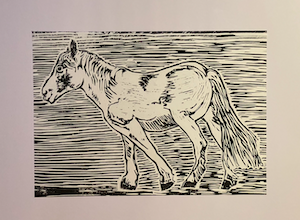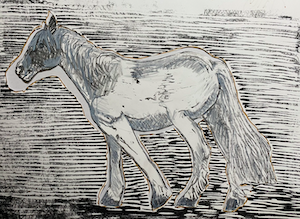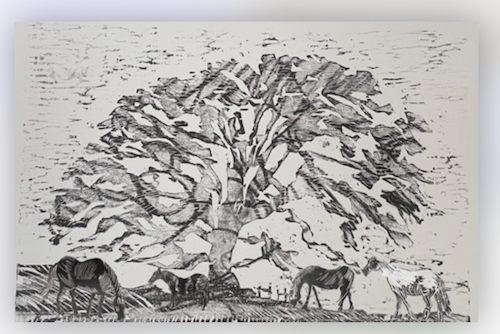Horses are tricky things to draw. Someone who knows horses will tell at a glance if the eyes are in the wrong place, the legs wouldn't work and it looks as if someone 'pinned the tail on' at a kid's birthday party. Trees are more forgiving, buildings better still. The human body is hardest of all - seven years of life drawing and I have a feel for it! But horses?!
I return to a scene in Northumberland of four horses in a paddock that has a huge, ancient beech tree in one corner. When it comes to the horses first, they have to look like horses - then a make of horse (I think 'breed' is the technical term!) will mean they are shorter, taller, fatter, perkier, hairier, or not ... and finally (as you'd want to achieve with a portrait of a person), they need to capture the character of the horse (even if it is a caricature: a Shetland pony is straight forward, maybe a cart-horse too, but there's everything else in between.

Once you think you have a drawing, or outline right this must then be transferred to a piece of lino or plywood, and the entire thing cut out. There is no going back (or I haven't found a way to do so). Therefore, after several days of 'cutting' and a few 'graphite rubbings' I ink up and print off an A3 sheet only to find that I've made the head and neck too large and the eye is in the wrong place. Who'd know? My sister was polite. I pointed out that the head was too big - she agreed. She'd been supplying me with pictures of feet all week so they looked OK - but not the head. My fault. I had drawn a larger, detailed head, photographed this, and superimposed it on the body without being careful enough to check back with the original. I hear my mother's voice over my shoulder (she died in 2012) - telling me to 'draw what you see'. Observation, constantly referring back to the real thing counts for a lot (not over referencing photographs).

Anyway. I thought of a solution overnight - I masked off the head, printed up and once dry I will, with great care, ink in a head. Basically, I'll tape a drawing to the French windows, overlay the part-print, draw in the correct head in pencil, then use black ink to finish it off. This isn't to be a finished print, as I will then cheat further by reducing the end result by 200-300%, printing off on fine paper and glue it to a monoprint + beech tree overlay.
